 |
|
San
Pedro, Altitude 3240m: What apperas quite a high altitude is only the
beginning: Three former Queensland Rail GL26C-2 from Australia head a long
train over the Ascotán-Pass to Ollagüe at the Bolivian border.
On the return trip, the train carries siver,
zinc and lead concentrate from the mines in San Cristobal, Bolivia to the port of Mejillones
in Chile. These
trains are the longest and heaviest on the FCAB. December 14, 2009.
San Pedro, Alt. 3240m:
Was sich wie schon ziemlich hoch anhört, ist bloss der Beginn: Drei
ex. Queensland Rail GL26C-2 aus Australien bringen einen langen Mineral Leerzug über den Ascotán-Pass nach
Ollagüe an der bolivianischen Grenze. In den Behältern wird Silber-,
Zink- und Blei-Konzentrat aus den Minen von San Cristobal, Bolivien
zum Hafen von Mejillones in Chile befördert. Diese Züge sind
die längsten und schwersten der FCAB.
|
|
|
|
|
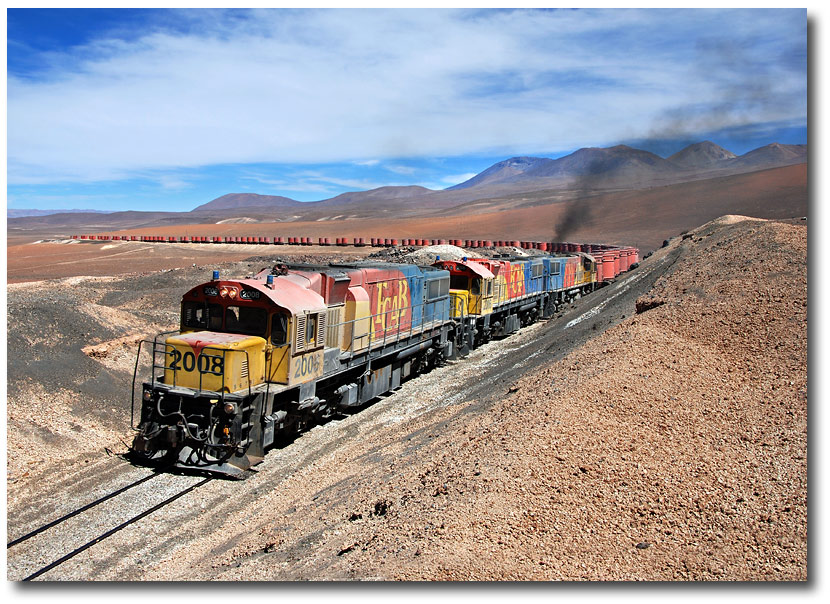 |
|
The
line over the Ascotán-Pass at 4000m is,
compared to all other railroads crossing the Anden range rather
unspectacular. It climbs the cordillera de los Andes without any
tunnels, and apart from the Rio Loa viaduct there are no
structures. Nevertheless, the three units #2008, 2006 and 2011 are
demanded on the long climb.
Die Strecke über den 4000m hohen Ascotán-Pass
ist verglichen mit allen anderen Bahnstrecken, welche über die
Andenkette führen ziemlich unspektakulär und kommt mit Ausnahme des Rio Loa
Viaduktes ohne jegliche Kunstbauten aus. Dennoch wird den Lokomotiven
auf der langen Rampenstrecken einiges abvelangt.
|
|
|
|
|
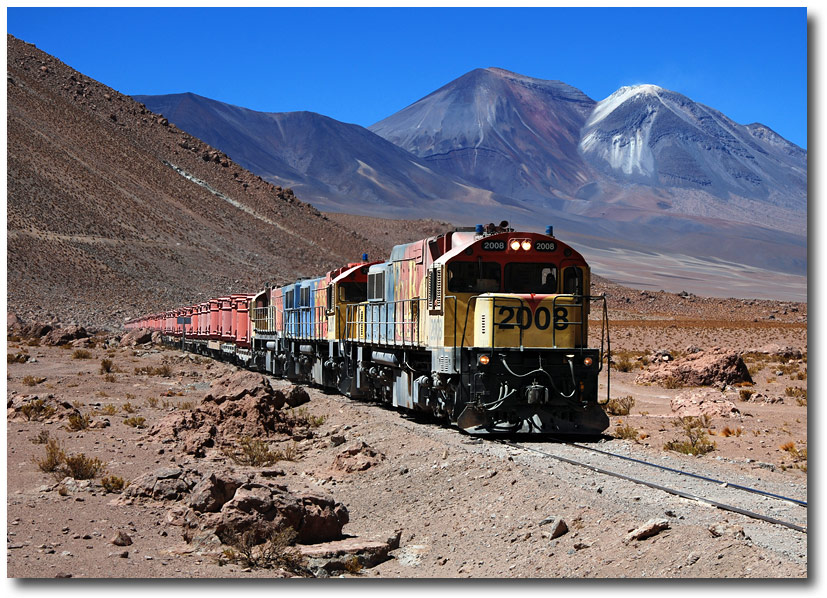 |
|
That
the line is comparatively easy doen't mean that its less scenic, to
the contrary: The volcanic landscape it passes offered plenty of interesting spots like this active
Volcano close to Ascotán.
Die Tatsache, dass die Strecke ohne
spektakuläre Kunstbauten auskommt heisst keineswegs, dass sie ohne
lanschaftliche Reize wäre, im Gegenteil: Salare und Vulkane wie der
Volcán hier bei Ascotán bieten Abwechslung und zahlreiche Motive.
|
|
|
|
|
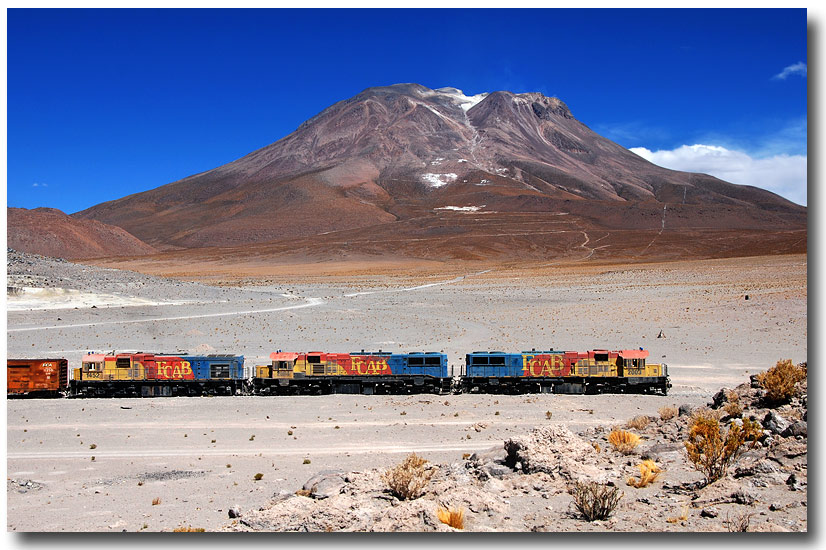 |
|
The Volcán Ollagüe in the picture here showed some
activity also. The
volcanic ash and lava in the foreground contrasted with the deep
blue sky of the Andes.
Auch der Vulkan Ollagüe unweit der
gleichnamigen Orstschaft zeigte leichte Aktivitäten. Die Vulkanasche
und das Lavagestein im Vordergrund kontrastieren mit dem stahlblauen
Himmel des Andenhochlands.
|
|
|
|
|

|
|
Mineral
traffic from Bolivia to the Pacific Port of Mejillones started in
2007, when the Mine of San Cristobal started its operation. Each
flatcar conveys two containers holding 21 tons of siver, zinc or lead
concentrate. Back in the 70ies, the excange of goods with Bolivia
accouted for 50% of the overall tonnages handled by FCAB. Until 2004,
this had dropped to a mere 8%. Thanks to the new transports from San
Cristobal Mine, this trend could be stopped and traffic levels from
and to Bolivia increased again. Der
Mineralverkehr von Bolivien zum 600km entfernten Pazifikhafen von
Mejillones startete 2007 mit der Aufnahme des Betriebs der Mine San
Cristobal. Auf jedem Flachwagen können zwei Behälter mit je 21
Tonnen Silber, Zink und Blei - Konzentrat befördert weden. Dank
diesen Transporten konnte der Rückgang des Verkehrs mit Bolivien
gebrochen werden. Noch in den 70er Jahren machte der Güteraustausch
mit Bolivien rund 50% der Transportmenge der FCAB aus, während er
2004 auf ganze 8% gesunken war.
|
|
|
|
|
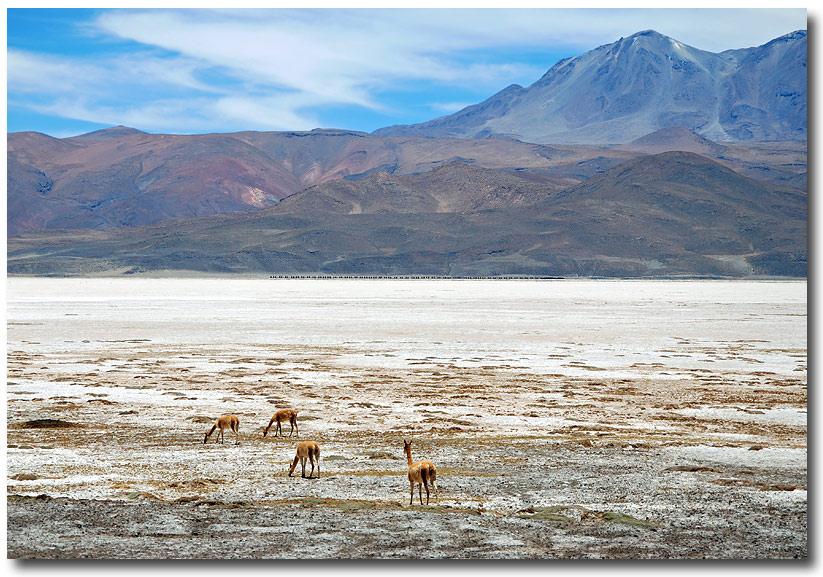
|
|
Vicuñas
graze at the border of the Salar de Caracote. Everything man-made
becomes insignificant in the vast remoteness of the Andes. Eine
Gruppe
Vicuñas am Rande des Salar de Caracote. In der weiten, grossartigen
Landschaft des Andenhochlandes verliert sich alles von Menschenhand
geschaffene unweigerlich.
|
|
|
|
|
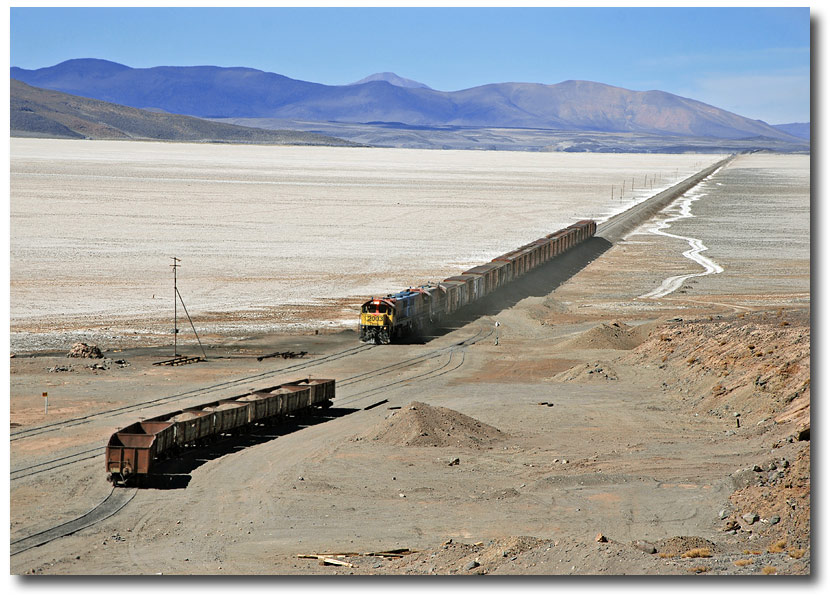 |
|
The
Salar de Carcote is a remnant of an ancient lake that dried up. The FCAB train passing the
salar with its Boxcars from Bolivia had been taken over from Bolivian
Empresa Ferroviaria Andina (FCA) at Ollagüe and moves goods to the
port of Antofagasta. Der Salar de Carcote war einst
ein See, der heute praktisch vollständig ausgetrocknet ist. Der FCAB
Zug wurde
bei Ollagüe von der Bolivianischen Empresa Ferroviaria Andina (FCA) übernommen und befördert
Güter zum Hafen von Antofagasta.
|
|
|
|
|
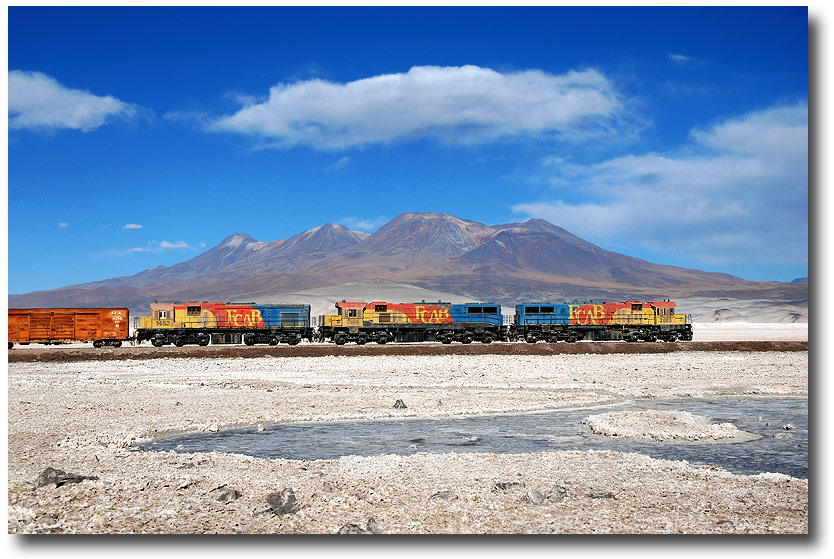 |
|
Australian "immigrants" in the Anden Highlands: The units GL26C-2
# 2003, 2004 and GL22C No.1452,
taken over by 2001 and 2005 from Queensland Rail, pass along
the Salar de Ascotán with a westbound freight. "Australische
Einwanderer" im Andenhochland: Die von Queensland Rail
in 2001 und 2005 übernommenen GL26C-2 Einheiten Nr. 2003, 2004 und
die GL22C Nr.1452 passierten hier den Salar de Asoctán
mit einem Richtung Westen fahrenden Güterzug. |
|
|
|
|
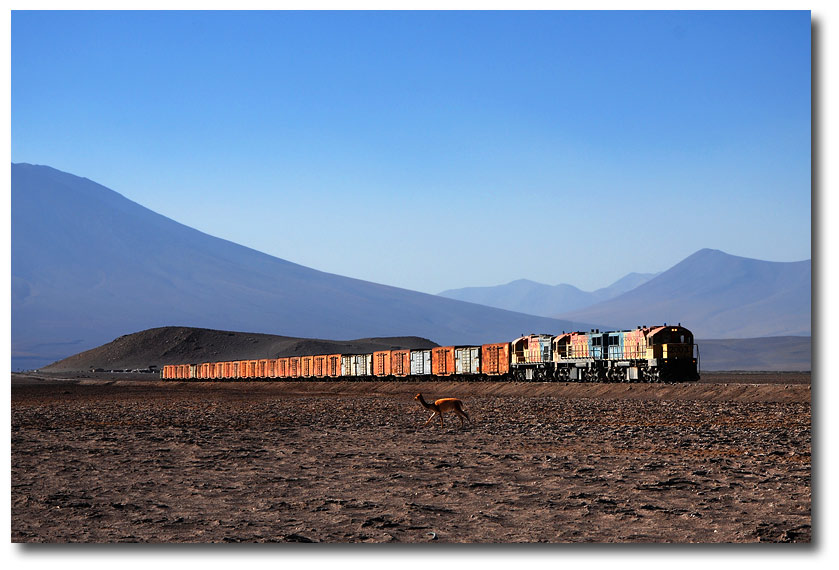 |
|
A
Vicuña living up there moved to a safer place as our train approached.
The Volcanic mountains in the background that appear just like hills
in fact reach 5000m/ 16'000ft.
Ein Vicuña brachte sich in Sicherheit, als sich unser Zug näherte.
Die bloss wie Hügel erscheinenden Vulkane im Hintergrund
erreichen in Wirklichkeit 5000 Meter und mehr.
|
|
|
|
|
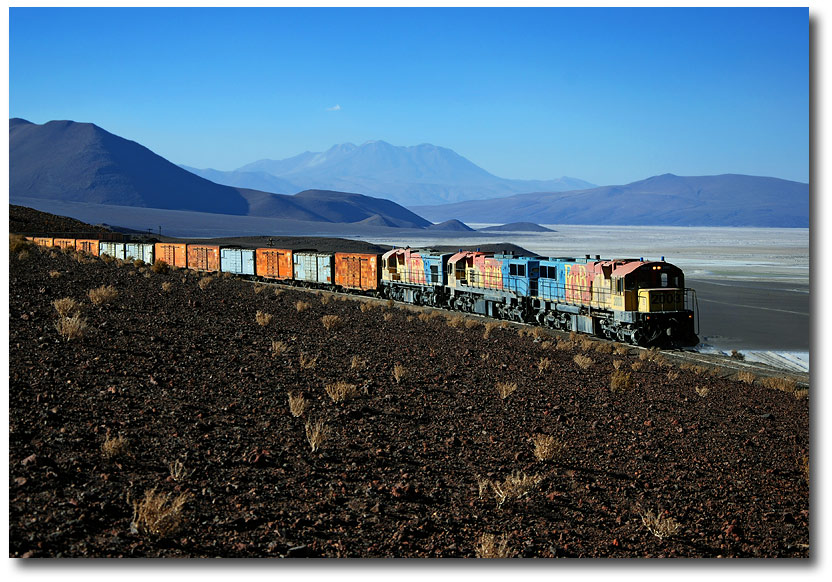 |
|
A
few kilometer further south along the Salar de Ascotán, the line had climbed high above the salar where we took this shot. On an altitude of 4000m, you feel every
step if not acclimated. It goes without saying that we were
totally short of breath when we eventually got to this spot, but we were rewarded by
this shot!
Einige Kliometer weiter südlich
entlang des Salar de Asoctán beginnt der Anstieg auf den
gleichnamigen Pass. Bereits hoch über dem Salzsee näherte sich hier der
Zug.
Auf 4000 Metern Höhe spürt man jeden Schritt, wenn man nicht
akklimatisiert ist, und wir waren beim Aufstieg zu dieser Stelle
entsprechend ausser Atem; dafür aber wurden wir mit diesem Bild belohnt!
|
|
|
|
|
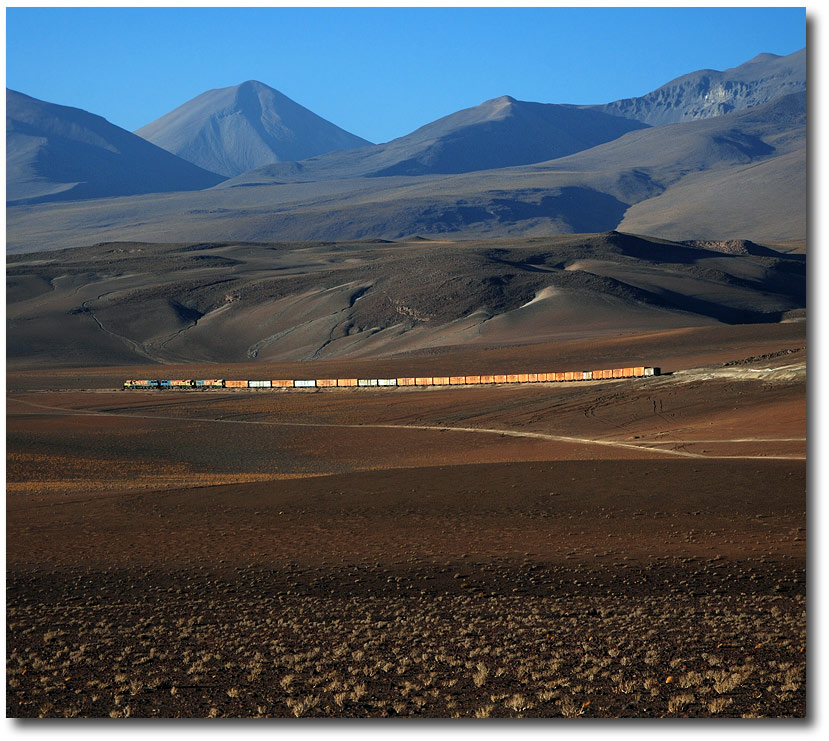 |
|
The
great, vast mountain scenery of the Andes totally dwarfs human scale. Die
weite, grossartigen Gebirgslandschaft
der Anden lässt alles
von Menschenhand erschaffene winzig erscheinen.
|
|





